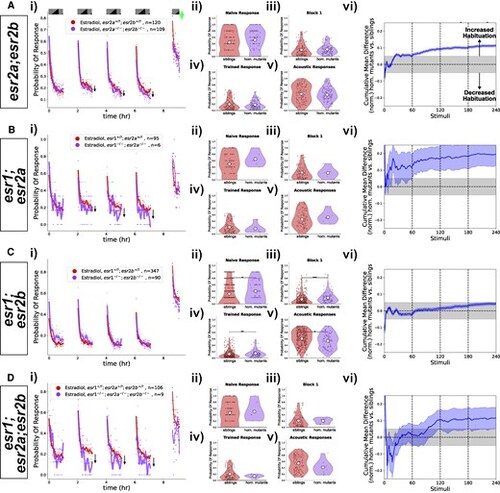Fig. 4
- ID
- ZDB-FIG-250728-106
- Publication
- Hsiao et al., 2025 - Estradiol promotes habituation learning via an unidentified target, bypassing the suppressive effects of established Ers
- Other Figures
- All Figure Page
- Back to All Figure Page
|
Double and triple mutant combinations of esr1, esr2a, and esr2a do not show habituation deficits after treatment with estradiol. A) Homozygous esr2a(−/−);esr2b(−/−) double mutants (n = 109 fish) do not show impaired habituation relative to double heterozygous or homozygous sibling controls ((+/?);(+/?), n = 120 fish). B) Homozygous esr1(−/−);esr2a(−/−) double mutants (n = 6 fish) do not show impaired habituation relative to double heterozygous or wild-type sibling controls ((+/?);(+/?), n = 95 fish). C) Homozygous esr1(−/−);esr2b(−/−) double mutants (n = 90 fish) do not show impaired habituation relative to double heterozygous or wild-type sibling controls ((+/?);(+/?), n = 347 fish). D) Homozygous esr1(−/−);esr2a(−/−);esr2b(−/−) triple mutants (n = 9 fish) do not show impaired habituation relative to triple heterozygous or wild-type sibling controls ((+/?);(+/?);(+/?), n = 106 fish). i)-vi) For each lettered section: i) Responsiveness to stimuli comparing homozygous mutants to sibling controls (heterozygous or wild-type). Each dot is the probability of response to one stimulus. Lines are smoothed in time with a Savitzky–Golay filter (window = 15 stimuli, order = 2). ii)-v) Distributions responsiveness for different epochs of the experiment. Each dot is the per-fish average of the epoch. Statistical significance was calculated using Mann-Whitney U test, * = P < .05, ** = P < .01, *** = P < .01. ii) the naive response to the first 5 DF stimuli; iii) the mean response to the remaining DF stimuli in the Block 1 (DFs 6:60); iv) the trained response to the last 45 DFs in all 4 training blocks (DFs 16:60,76:120,136:180,196:240); v) the 30 vibration stimuli delivered with a tap from a solenoid on the 300-well plate platform. vi) Cumulative mean difference (CMD) plot quantifying habituation performance of mutants relative to sibling controls. |

